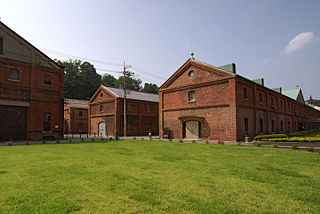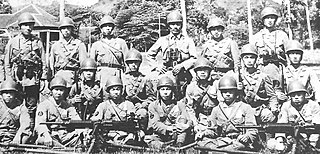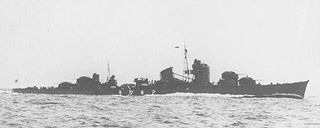Related Research Articles

Maizuru is a city in Kyoto Prefecture, Japan. As of 28 February 2022, the city had an estimated population of 78,644 in 34817 households and a population density of 230 persons per km². The total area of the city is 342.13 square kilometres (132.10 sq mi).

Minoru Ōta was an admiral in the Imperial Japanese Navy during World War II, and the final commander of the Japanese naval forces defending the Oroku Peninsula during the Battle of Okinawa.

The Special Naval Landing Forces were naval infantry units of the Imperial Japanese Navy (IJN) and were a part of the IJN Land Forces. They saw extensive service in the Second Sino-Japanese War and the Pacific theatre of World War II.

Kisaragi was one of twelve Mutsuki-class destroyers, built for the Imperial Japanese Navy (IJN) during the 1920s. Retreating after the sinking of destroyer Hayate by American coast-defense guns during the Battle of Wake Island in December 1941, Kisaragi was sunk with all hands by American aircraft. She had the distinction of being the second major Japanese warship lost during the war . She should not be confused with an earlier World War I-period Kamikaze-class destroyer with the same name.

Nagara (長良) was the lead ship of her class of light cruiser in the Imperial Japanese Navy. She was named after the Nagara River in the Chūbu region of Japan.

The Imperial Japanese Navy fielded naval paratroopers during World War II. The troops were officially part of the Special Naval Landing Forces. They came from the 1st, 2nd and 3rd Yokosuka SNLFs. The 2nd Yokosuka took no part in any airborne operations and became an island defensive base unit. They were under the operational control of the Imperial Japanese Navy Air Service. Rikusentai paratroopers should not be confused with the Imperial Japanese Army paratroopers, known as Teishin.
The 4th Fleet was a fleet of the Imperial Japanese Navy. The Fourth Fleet designation was used during three separate periods. The initial designation was for a group of ships that were assigned to work together during the Russo-Japanese conflict and the period of its immediate aftermath. The second time the designation was used was during the Sino-Japanese conflict, and the third time was as a South Pacific area of command during the middle of the Pacific War.

Maizuru Naval Arsenal was one of four principal naval shipyards owned and operated by the Imperial Japanese Navy.

Maizuru Naval District was one of four main administrative districts of the pre-war Imperial Japanese Navy. Its territory included the entire Sea of Japan coastline from northern Kyūshū to western Hokkaidō.
The 3rd Kure Special Naval Landing Force were two infantry battalions of the Imperial Japanese Navy's Special Naval Landing Forces.

The 5th Sasebo Special Naval Landing Force was an infantry battalion of the Imperial Japanese Navy's Special Naval Landing Forces.
The 5th Kure Special Naval Landing Force was a naval infantry battalion of the Imperial Japanese Navy's Special Naval Landing Forces.
The 5th Yokosuka Special Naval Landing Force was an infantry battalion of the Imperial Japanese Navy's Special Naval Landing Forces.
Masajiro Hayashi was an officer in the Imperial Japanese Navy during World War II. He was a member of the 51st Class of the Imperial Japanese Naval Academy, ranking 182 out of 255 Cadets. He was in command of forces during the Battle of Milne Bay until he was apparently killed during the battle. Other sources state that he was relieved of command by Minoru Yano.
Ro-68 was an Imperial Japanese Navy Type L submarine of the L4 subclass. First commissioned in 1925, she served in the waters of Japan prior to World War II. During World War II, she supported Japanese forces during the Battle of Wake Island and the invasion of Rabaul and took part in the Aleutian Islands campaign. She served as a training submarine from late 1942 to late 1944 before returning to a combat role in Japanese waters late in the war. She surrendered to the Allies in 1945 at the conclusion of the war and was scuttled in 1946.

The Japanese occupation of the Gilbert Islands was the period in the history of Kiribati between 1941 and 1945 when Imperial Japanese forces occupied the Gilbert Islands during World War II, in the Pacific War theatre.

JDS Murasame (DD-107) was the lead ship of the Murasame-class destroyer of Japan Maritime Self-Defense Force.

JDS Yūdachi (DD-108) was the second ship of the Murasame-class destroyer of Japan Maritime Self-Defense Force.
Sanuki Maru (Japanese:讃岐丸) was a 1939-built cargo ship, requisitioned as a seaplane tender by the Imperial Japanese Navy during World War II.